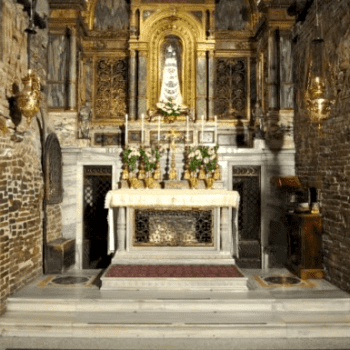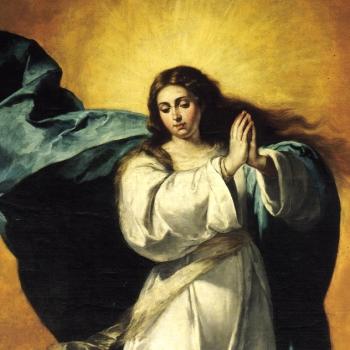The image here comes from St. James Cathedral in Orlando. I took it last year during my vacation. It depicts the Virgin Mary as the Mother of the Church—the very feast we are marking for the first time today — and shows her gathering her children under her protective, motherly mantel.
My colleague at CNEWA, the Rev. Elias Mallon, wrote about this feast last week and helped put this day in context:
The number of titles given to Mary in the Roman Catholic Church almost goes beyond counting. Some, like Mother of God (Greek: theotokos) are extremely ancient, while others like Mother of the Church seem more recent. In a sense,”Mary, Mother of the Church” is a title both ancient and recent.
Looking back, we find that mention of ”Mary, Mother of the Church” is rare in Catholic history. In 1895, Pope Leo XIII in his encyclical ”Adjutricem populi” (“Helper of the People”) referred to Mary as “Mother of the Church and Queen of the Apostles.” But we rarely hear mention of that title again until the Second Vatican Council.
There, it appears in the Vatican II document ”Lumen Gentium” (the Dogmatic Constitution on the Church, 21 November 1964). After dealing with the church from almost every aspect, the bishops at the Council decided to add a chapter (VIII) on “Our Lady.” Although the Council does not give him credit, the German theologian Hugo Rahner in 1944 showed that Ambrose (ca. 340-397), bishop of Milan and a Church Father, saw in Mary a type/image of the church. The Council refers to Ambrose and this teaching and develops it.
The title ”Mary, Mother of the Church,” as understood by Vatican II, is extremely important. The church at the same Council committed itself, among other things, to ecumenism — to the work of restoring unity to Christians. The Council was aware that there have been and continue to be different attitudes towards Mary among Christians. Protestant Christians have sometimes disapproved of Marian devotion, seeing it as taking away from the unique role of Christ. Some have even seen the devotion as idolatrous.
Vatican II was aware not only of the deep importance of devotion to Mary, but also aware of some of the excesses that had grown up over the centuries. The Council “strongly urges theologians and preachers … to be careful to refrain as much from all false exaggeration as from too summary an attitude in considering the special dignity of the Mother of God” (LG par. 67). It reminds the faithful “that true devotion consists neither in sterile or transitory affection, nor in a certain vain credulity, but proceeds from true faith.” (ibid.)
This title recognizes that faith, and recognizes Mary as the mother of all Christians. Her maternal embrace enfolds all under mantel. Modern popes have used the term repeatedly; since 1964, the title ”Mary, Mother of the Church” has been used by every pope since Pope John XXIII.
But it wasn’t until now, with this new feast, that Pope Francis has given it expression in the devotional life of the church.












